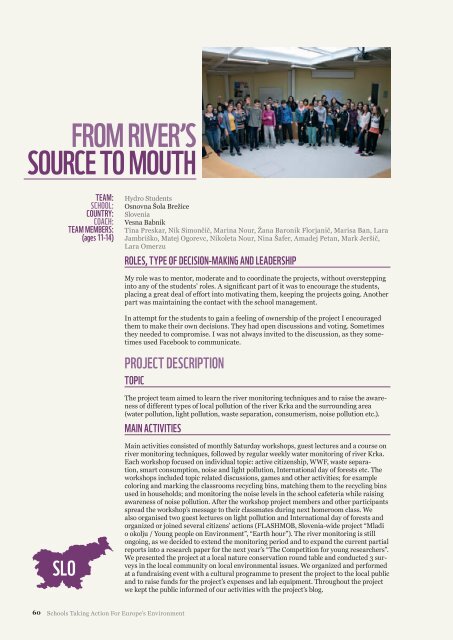esfalp_v_-_web_small.pdf - European schools for a living planet
esfalp_v_-_web_small.pdf - European schools for a living planet
esfalp_v_-_web_small.pdf - European schools for a living planet
- No tags were found...
Create successful ePaper yourself
Turn your PDF publications into a flip-book with our unique Google optimized e-Paper software.
From river’ssource to mouthTEAM:SCHOOL:COUNTRY:COACH:TEAM MEMBERS:(ages 11-14)Hydro StudentsOsnovna Šola BrežiceSloveniaVesna BabnikTina Preskar, Nik Simončič, Marina Nour, Žana Baronik Florjanič, Marisa Ban, LaraJambriško, Matej Ogorevc, Nikoleta Nour, Nina Šafer, Amadej Petan, Mark Jeršič,Lara OmerzuROLES, TYPE OF DECISION-MAKING AND LEADERSHIPMy role was to mentor, moderate and to coordinate the projects, without oversteppinginto any of the students’ roles. A significant part of it was to encourage the students,placing a great deal of ef<strong>for</strong>t into motivating them, keeping the projects going. Anotherpart was maintaining the contact with the school management.In attempt <strong>for</strong> the students to gain a feeling of ownership of the project I encouragedthem to make their own decisions. They had open discussions and voting. Sometimesthey needed to compromise. I was not always invited to the discussion, as they sometimesused Facebook to communicate.PROJECT DESCRIPTIONTOPICThe project team aimed to learn the river monitoring techniques and to raise the awarenessof different types of local pollution of the river Krka and the surrounding area(water pollution, light pollution, waste separation, consumerism, noise pollution etc.).MAIN ACTIVITIESSLOMain activities consisted of monthly Saturday workshops, guest lectures and a course onriver monitoring techniques, followed by regular weekly water monitoring of river Krka.Each workshop focused on individual topic: active citizenship, WWF, waste separation,smart consumption, noise and light pollution, International day of <strong>for</strong>ests etc. Theworkshops included topic related discussions, games and other activities; <strong>for</strong> examplecoloring and marking the classrooms recycling bins, matching them to the recycling binsused in households; and monitoring the noise levels in the school cafeteria while raisingawareness of noise pollution. After the workshop project members and other participantsspread the workshop’s message to their classmates during next homeroom class. Wealso organised two guest lectures on light pollution and International day of <strong>for</strong>ests andorganized or joined several citizens’ actions (FLASHMOB, Slovenia-wide project “Mladio okolju / Young people on Environment”, “Earth hour”). The river monitoring is stillongoing, as we decided to extend the monitoring period and to expand the current partialreports into a research paper <strong>for</strong> the next year’s “The Competition <strong>for</strong> young researchers”.We presented the project at a local nature conservation round table and conducted 3 surveysin the local community on local environmental issues. We organized and per<strong>for</strong>medat a fundraising event with a cultural programme to present the project to the local publicand to raise funds <strong>for</strong> the project’s expenses and lab equipment. Throughout the projectwe kept the public in<strong>for</strong>med of our activities with the project’s blog.60 Schools Taking Action For Europe’s Environment



